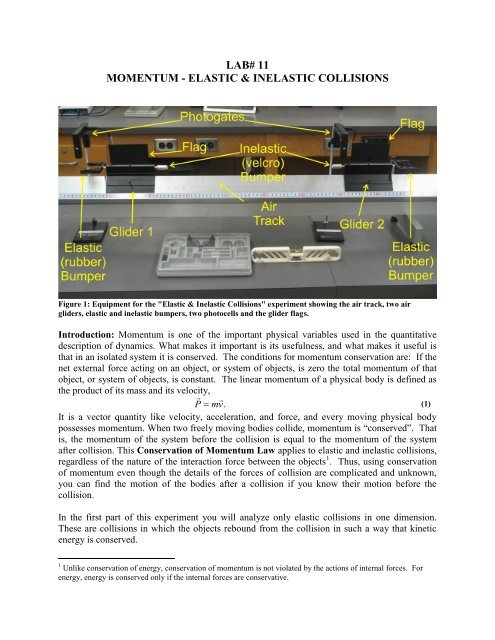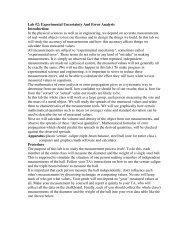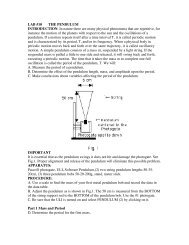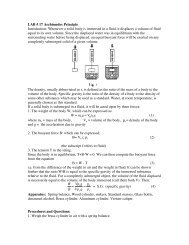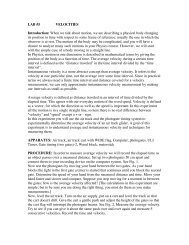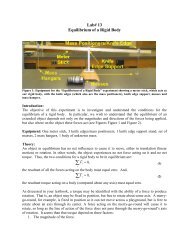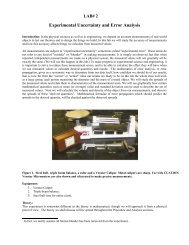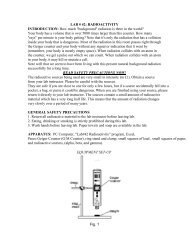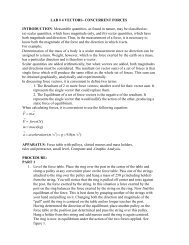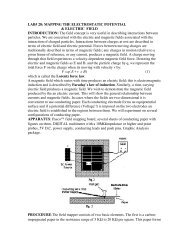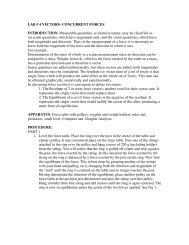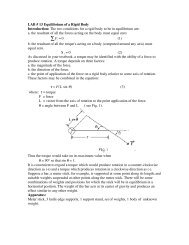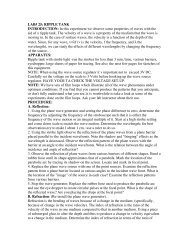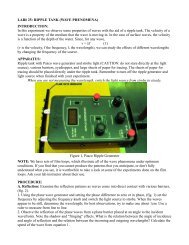Momentum - Elastic & Inelastic Collisions PART 1 Elastic Collisions
Momentum - Elastic & Inelastic Collisions PART 1 Elastic Collisions
Momentum - Elastic & Inelastic Collisions PART 1 Elastic Collisions
You also want an ePaper? Increase the reach of your titles
YUMPU automatically turns print PDFs into web optimized ePapers that Google loves.
LAB# 11<br />
MOMENTUM - ELASTIC & INELASTIC COLLISIONS<br />
Figure 1: Equipment for the "<strong>Elastic</strong> & <strong>Inelastic</strong> <strong>Collisions</strong>" experiment showing the air track, two air<br />
gliders, elastic and inelastic bumpers, two photocells and the glider flags.<br />
Introduction: <strong>Momentum</strong> is one of the important physical variables used in the quantitative<br />
description of dynamics. What makes it important is its usefulness, and what makes it useful is<br />
that in an isolated system it is conserved. The conditions for momentum conservation are: If the<br />
net external force acting on an object, or system of objects, is zero the total momentum of that<br />
object, or system of objects, is constant. The linear momentum of a physical body is defined as<br />
the product of its mass and its velocity,<br />
<br />
P mv.<br />
(1)<br />
It is a vector quantity like velocity, acceleration, and force, and every moving physical body<br />
possesses momentum. When two freely moving bodies collide, momentum is “conserved”. That<br />
is, the momentum of the system before the collision is equal to the momentum of the system<br />
after collision. This Conservation of <strong>Momentum</strong> Law applies to elastic and inelastic collisions,<br />
regardless of the nature of the interaction force between the objects 1 . Thus, using conservation<br />
of momentum even though the details of the forces of collision are complicated and unknown,<br />
you can find the motion of the bodies after a collision if you know their motion before the<br />
collision.<br />
In the first part of this experiment you will analyze only elastic collisions in one dimension.<br />
These are collisions in which the objects rebound from the collision in such a way that kinetic<br />
energy is conserved.<br />
1 Unlike conservation of energy, conservation of momentum is not violated by the actions of internal forces. For<br />
energy, energy is conserved only if the internal forces are conservative.
In the second part of this experiment we will investigate inelastic collisions. These are collisions<br />
where the objects stick together and/or deform so that kinetic energy in not conserved.<br />
Specifically, we will investigate perfectly inelastic collisions. This is a collision where the<br />
objects stick together and move off as one after the collision with the same final velocity.<br />
Equipment: Pasco® air track, the “Lab# 11 <strong>Collisions</strong>” program, two gliders, air track parts kit<br />
which includes the elastic and inelastic bumpers, along with two flags and two photocells. See<br />
Figure 1.<br />
Figure 2 Bumper Plate. One possible choice for bumper in elastic collisions.<br />
NOTE WELL: The computer has only one timer, so it can not time two overlapping intervals. In each<br />
of the following collision experiments, two gliders and two photogates are used. Your time<br />
measurements will be accurate if there is never more than one photogate blocked at any instant. It takes<br />
a little thought and maybe some trial and error to get your data in this experiment. When repeating a<br />
single set of experimental conditions and using the computer to determine the mean velocities: be sure<br />
to cross out any data in which the measured time intervals overlap.<br />
(Hint: Fill in the open circles in front of the procedure steps to help you perform the experiment)<br />
Procedure:<br />
o For all parts of this experiment you will use two gliders of equal mass (m a = m b ).<br />
Attach<br />
counterweights so that the masses of the gliders are equal.<br />
o Find the mass of the gliders after you have attached the bumpers and counterweights. As<br />
shown in Figure 1, attach the rubber band bumper to one glider and a bumper plate to the<br />
other. Note: Some groups find that using two rubber band bumpers, as shown in Figure 1,<br />
and turning one so that they are at 90 angles relative to each other gives better results than<br />
using the bumper plate, see Figure 2. Whichever method you choose is acceptable, just be<br />
sure to be consistent.<br />
o On the opposite ends of the gliders, attach the Velcro bumper for the second part of the<br />
experiment.<br />
o Carefully level the airtrack.
o After you are convinced that the airtrack is level (the gliders don't accelerate in either<br />
direction), and the gliders have equal masses, place two photogates, separated by some<br />
distance from each other, as indicated in Figures 1 and 3.<br />
o In any experiment using two photogates, keep both photogates parallel to each other. And<br />
remember to keep the flag perpendicular to the beam.<br />
<strong>PART</strong> 1 <strong>Elastic</strong> <strong>Collisions</strong>:<br />
Figure 3. <strong>Elastic</strong> collision, mass m a initially at rest. Part 1A<br />
A. Equal masses, one glider at rest.<br />
In the first part of this experiment you setup a collision between the gliders in which one of the<br />
gliders, m a , is initially at rest. See Figure 3.<br />
o Confirm that the airtrack is level.<br />
o Make sure the gliders will collide so that the rubber bumper on one hits the bumper plate, or<br />
the rubber bumper, on the other properly.<br />
o Plug the photogates into the proper ports on the Labpro interface, and open the “Lab# 11<br />
<strong>Collisions</strong>” icon.<br />
o Turn on the air supply to the airtrack and place both gliders on the airtrack.<br />
o Keep glider m a at rest and slightly push m b allowing it to slide freely with a constant velocity<br />
o Be sure that m b passes completely through photogate I before m a enters photogate II.<br />
o Note: Pay special attention to the order of the photogates in the experiment. This information<br />
is necessary to find the correct velocity.<br />
o Repeat this procedure for three (3) trials.<br />
Analysis:<br />
We wish to determine if the momentum of the system was conserved by calculating, and<br />
comparing, the momentum of the system before and after the collision. We will also compare<br />
the kinetic energy of the system before and after the collision to determine if it was conserved.<br />
Since m a was initially at rest the initial and final momentums of the system are given by,<br />
<br />
pi<br />
mbvbi<br />
<br />
(2)<br />
p m v m v<br />
f<br />
The initial and final kinetic energies of the system are given by,<br />
b<br />
bf<br />
a<br />
af
K<br />
f<br />
<br />
K<br />
1<br />
2<br />
<br />
1<br />
i 2 b<br />
2<br />
b bf<br />
m v<br />
m v<br />
<br />
2<br />
bi<br />
1<br />
2<br />
m<br />
a<br />
v<br />
2<br />
af<br />
(3)<br />
Enter the values of your measurements into a table, such as Table 1 below (don’t forget your<br />
units!). Comment on whether momentum was conserved in the collisions. Also comment on<br />
whether kinetic energy was conserved in the collisions. Was there any noticeable relationship<br />
between the initial speed of m b and the final speed of m a ? HINT: What was the apparent speed<br />
of m b after the collision? Looking at Equations (2) and (3) should convince you that for an<br />
initially stationary m a an exchange of velocities between m a and m b is the only possibility.<br />
v bi v af p i p f Ki K f Δp ΔK<br />
Table 1 <strong>Elastic</strong> Collision: One glider at rest.<br />
B. Equal masses, both gliders moving<br />
In this elastic collision both gliders will be in motion towards each other. See Figure 4..<br />
Figure 4. <strong>Elastic</strong> collision, both masses in motion. Part 1B.<br />
In Order to be able to correctly measure the speeds of the gliders when both will be moving<br />
you must adjust the initial positions and velocities such that:<br />
m b passes through photogate I before m aa reaches photogate II.<br />
m a passes through photogate II before m b rebounds back through photogate I.<br />
m b passes back through photogate I before m a rebounds back through photogate II.<br />
Hint: Start m b first with a slow velocity, then, after m b passes photogate I, start m a through<br />
photogate II with a faster velocity. If the collision is performed correctly, the computer will<br />
run through two complete sequences of the collision timing mode, showing all four transit<br />
times.<br />
o Confirm that the airtrack is level.
o Make sure the gliders will collide so that the rubber bumper on one hits the bumper plate, or<br />
the rubber bumper, on the other properly.<br />
o Again, use the “Lab# 11 <strong>Collisions</strong>” Program.<br />
o Turn on the air supply to the airtrack and place both gliders on the airtrack.<br />
o Keep glider m a at rest and slightly push m b allowing it to slide freely with a constant velocity<br />
o Be sure that m b passes completely through photogate I before m a enters photogate II.<br />
o Note: Pay special attention to the order of the photogates in the experiment. This information<br />
is necessary to find the correct velocity.<br />
o Repeat this procedure for three (3) trials.<br />
Analysis:<br />
We again wish to determine if the momentum, as well as the kinetic energy, of the system was<br />
conserved by calculating, and comparing, their respective values before and after the collision.<br />
Since in this part of the experiment both m a and m b were initially moving the initial and final<br />
momentums of the system are given by,<br />
<br />
pi<br />
mbvbimavai<br />
<br />
(4)<br />
p m v m<br />
v<br />
f<br />
b<br />
bf<br />
a<br />
af<br />
The initial and final kinetic energies of the system are given by,<br />
K<br />
K<br />
f<br />
i<br />
<br />
<br />
1<br />
2<br />
1<br />
2<br />
2<br />
b bi<br />
2<br />
b bf<br />
m v<br />
m v<br />
<br />
1<br />
2<br />
<br />
m<br />
1<br />
2<br />
2<br />
abvai<br />
2<br />
avaf<br />
m<br />
(5)<br />
Enter the values of your measurements into a table, such as Table 2 below (don’t forget your<br />
units!). Notice we did use vector notation in equations (4). That is because, even though the<br />
collisions occurred in one dimension, and the full use of vectors is not necessary, momentum is a<br />
vector quantity and you must account for its direction by use of the correct sign. This is the<br />
special case of the use of vectors in one dimension. Typically we take the initial direction of m b<br />
to be the positive direction, so its initial velocity is positive. That makes the initial velocity of m a<br />
negative. In short you must pick a direction to be the positive direction and than account for that<br />
in your calculation of momentum. Comment on whether momentum was conserved in the<br />
collisions. Also comment on whether kinetic energy was conserved in the collisions.<br />
v bi v ai v bf v af p i p f Ki K f Δp ΔK<br />
Table 2 <strong>Elastic</strong> collision: Both gliders moving.<br />
A very useful physical quantity in the study of collisions is that of impulse,<br />
Fdtp.<br />
<br />
I (6)<br />
Impulse gives us a measure of how much an object’s momentum was changed. In a collision<br />
between two objects the impulse delivered to m b by m a must be equal in magnitude and opposite
in direction to the impulse delivered to object m a by object m b (a restatement of Newton’s third<br />
law). Calculate the impulse each mass delivers to the other and comment on whether the<br />
impulses are equal in magnitude and opposite in direction.<br />
p bi p ai p bf p af Δp a Δp b I a I b<br />
Table 3: <strong>Elastic</strong> Collision: Impulse calculation.<br />
Comment on any noticeable relationship between the initial and final speeds speed of m b and m a ?<br />
HINT: This result is only true for elastic collisions between equal mass objects. You may wish<br />
to take a look at your textbook for the final velocities of objects after an elastic collision.<br />
<strong>PART</strong> 2 <strong>Inelastic</strong> <strong>Collisions</strong>: equal masses, one glider initially moving.<br />
We have dealt with the concept of momentum and its conservation for elastic collisions in one<br />
dimension. Now, we can observe the case of an inelastic collision and see whether the law of<br />
conservation of momentum holds under these conditions. When a collision is inelastic, the<br />
kinetic energy is not conserved and is converted to thermal energy and is sometimes used in the<br />
physical deformation of the objects (i.e. automobile accidents). However, it turns out that the<br />
conservation of momentum is still valid. In some situations, such as an explosion, potential<br />
energy is released during the collision and the final kinetic energy may be larger than the initial<br />
kinetic energy! Of course the total kinetic plus potential energy of the system is still conserved 2 .<br />
In the inelastic collision analyzed in this lab, see Figure 5, the two bodies stick together after<br />
collision and have, therefore, a common final velocity. Strictly speaking this type of collision is<br />
termed a perfectly inelastic collision since the objects stick together and move off with the same<br />
final velocity. Again you will be using the “Lab# 11 <strong>Collisions</strong>” program.<br />
o If you have not already done so, attach the Velcro bumpers on the gliders so that, upon<br />
collision, the gliders stick together.<br />
o Be sure to attach matching weights to the opposite end of each glider so the gliders continue<br />
to have equal mass.<br />
o Turn on the air supply to the air track.<br />
o With glider m a at rest between the photogates, push m b allowing it to move completely<br />
through photogate I before colliding with m a .<br />
o After passing photogate I. m b will collide with m a . They will stick together and move along<br />
the track with a common final velocity.<br />
o The computer will record the transit time, and calculate the velocity, of m a (now connected<br />
with m b ) through photogate II.<br />
2 In any event if one adds up all forms of energy, kinetic, potential, thermal, etc. the total energy is always strictly<br />
conserved.
Figure 5. <strong>Inelastic</strong> collision, mass m a initally at rest. Part 2.<br />
Analysis:<br />
As with the previous parts of this experiment we wish to determine if the momentum, as well as<br />
the kinetic energy, of the system was conserved. In this part of the experiment m a was initially at<br />
rest, and m a and m b had the same final velocities. Therefore the initial and final momentums of<br />
the system are give by,<br />
p m v<br />
p<br />
f<br />
i<br />
b<br />
b<br />
bi<br />
( m m<br />
) v<br />
a<br />
f<br />
(7)<br />
The initial and final kinetic energies of the system are given by,<br />
K<br />
f<br />
1 2<br />
i<br />
<br />
2<br />
mbvbi<br />
1<br />
2<br />
2<br />
( mb<br />
ma<br />
) v<br />
f<br />
K<br />
<br />
(8)<br />
Enter the values of your measurements into a table, such Table 4 below. Comment on whether<br />
momentum was conserved in the collisions. Also comment on whether kinetic energy was<br />
conserved in the collisions. If kinetic energy was not conserved, where do you think it went?<br />
What percentage of the systems initial kinetic energy was converted to other forms of energy?<br />
v bi v f p i p f Ki K f Δp ΔK %K i “lost”<br />
Table 4 <strong>Inelastic</strong> collision: One glider at rest.<br />
Questions:<br />
1. The relationship of velocities,<br />
vbf<br />
vaf<br />
,<br />
(9)<br />
vai<br />
vbi<br />
is called the coefficient of restitution. Using one of your trials from part (2) of this experiment<br />
and one of your trials from part (1A) of this experiment calculate the coefficient of restitution for<br />
these two situations. Describe, in your own words, what the coefficient of restitution for a<br />
collision tells us. You may wish to think, for example, in terms of the collision that takes place<br />
between a racket ball and a racket (http://www.racquetresearch.com/coeffici.htm).
2. It is interesting to note the change in momentum of the target object, for us m a , in the two<br />
different types of collisions (m a initially at rest is the elastic and perfectly inelastic collisions).<br />
Pick a trial from part (1A) and part (2) where the initial velocities of m b are as similar as<br />
possible. Calculate the change in momentum of m a for the two cases and comment on the<br />
differences. Specifically for which case is the change in momentum for m a the greatest? Briefly<br />
explain why this makes sense, from the point of view of conservation of momentum.<br />
HINT: momentum is a vector! Lastly, let us say you are a scientist or engineer working for<br />
NASA and you are tasked with the responsibility of diverting an asteroid heading straight for<br />
Earth. You know that you must deflect the asteroid as much as possible (without breaking it into<br />
many Earth destroying pieces). The asteroid is the target. Would you want your projectile to<br />
make an elastic or inelastic collision with the asteroid, in the hopes of changing its momentum<br />
by the greatest amount? Briefly explain. Good luck with that task, no pressure!


